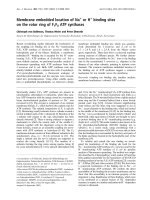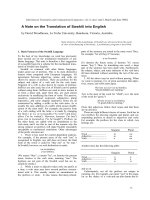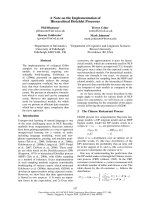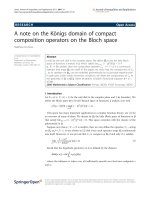1. A note on the endomorphism ring of orthogonal modules
Bạn đang xem bản rút gọn của tài liệu. Xem và tải ngay bản đầy đủ của tài liệu tại đây (148.56 KB, 4 trang )
<span class='text_page_counter'>(1)</span><div class='page_container' data-page=1>
Vinh University Journal of Science, Vol. 48, No. 2A (2019), pp. 5-8
A NOTE ON THE ENDOMORPHISM RING
OF ORTHOGONAL MODULES
Le Van An, Nguyen Thi Hai Anh
Department of Education, Ha Tinh University, Ha Tinh City, Vietnam
Received on 25/4/2019, accepted for publication on 13/6/2019
Abstract: In this paper, we extend MohamedMuăllers results [2, Lemma 3.3]
about the endomorphism ring of a module M = ⊕i∈IMi, whereMi and Mj are
orthogonal for all distinct elementsi, j∈I.
1
Introduction
All rings are associated with identity, and all modules are unital right modules. The
endomorphism ring of M are denoted End(M). A submodule N of M is said to be an
essential(notationally N ⊂e<sub>M</sub><sub>) if</sub> <sub>N</sub> <sub>∩</sub><sub>K</sub> <sub>6</sub><sub>= 0</sub> <sub>for every nonzero submodule</sub> <sub>K</sub> <sub>of</sub> <sub>M</sub><sub>. Two</sub>
modulesM and N are called orthogonal if they have no nonzero isomorphic submodules.
LetN be a rightR−module. A moduleM is said to beN−injectiveif for every submodule
X ofN, any homomorphismϕ:X−→M can be extended to a homomorphismψ:N −→
M. Two modules M and N are called relatively injective if M is N−injective and N is
M−injective. In [2, Lemma 3.3], S. H. Mohamed and B. J. Muăller proved that:
Let M =M1⊕M2. If M1 and M2 are orthogonal, then
S/∆∼=S1/∆1×S2/∆2.
The converse holds ifM1 and M2 are relatively injective, where
S=End(M), Si=End(Mi)(i= 1,2)
and
∆ ={s∈S|Ker(s)⊂e<sub>M</sub><sub>}</sub><sub>,</sub><sub>∆</sub>
i ={si ∈Si |Ker(si)⊂eMi}(i= 1,2).
In this paper, we study [2, Lemma 3.3] in generalized case. We have:
Theorem A. (i). Let M = ⊕i∈IMi be a direct sum of submodules such that Mi and
Mj are orthogonal for anyi, j of I and i6=j, then Q<sub>i</sub>∈ISi/∆i is embedded into S/∆.
In particular, if I is a finite set, Q
i∈ISi/∆i∼=S/∆.
(ii). LetM =⊕<sub>i</sub>∈IMi be a direct sum of submodules such that Mi andMj are relatively
injective for any i, j of I, i 6= j and Q
i∈ISi/∆i ∼=S/∆, then Mi and Mj are orthogonal
with i, j of I and i 6= j, where S = End(M), Si = End(Mi)(i ∈ I) and ∆ = {s ∈ S |
Ker(s)⊂e<sub>M</sub><sub>}</sub><sub>,</sub> <sub>∆</sub>
i ={si ∈Si |Ker(si)⊂eMi}(i∈I).
1)
Email: (L. V. An)
</div>
<span class='text_page_counter'>(2)</span><div class='page_container' data-page=2>
Le Van An, Nguyen Thi Hai Anh / A note on the endomorphism ring of orthogonal modules
2
Proof of Theorem A
(i). Lets be an element of the endomorphism ring S and x an element of the module
M, then x = P
i∈Ixi with xi 6= 0 for every i ∈ I
0 <sub>(where</sub> <sub>I</sub>0 <sub>is the finite subset of</sub> <sub>I</sub><sub>),</sub>
s(x) = P
i∈Is(xi). Because s(xi) is an element of M, thus s(xi) = Pj∈Isij(xi) with
sij(xi) =pj◦s(xi) is an element ofMj (wherepj :M −→Mj is a natural homomorphism,
sij(xi) 6= 0 for every j ∈ I0, I0 is finite and I0 is a subset of I). We consider the matrix
s= [sij]I×I withsij :Mi −→Mj being homomorphism. Note that,sij is an endomorphism
ofM because sij(Pj∈Ixj) = 0 +...+ 0 +sij(xi) + 0 +...
Claim 1. Ker(sij) is an essential submodule of M for every i, j belonging to I and
i6=j.
LetN be a nonzero submodule of M andKer(sij)∩N = 0, thensij |N is a
monomor-phism, thusN ∼=sij(N) withsij(N)being a submodule of Mj. Butsij(⊕k6=iMk) = 0, thus
⊕<sub>k</sub>6=iMkis a submodule ofKer(sij). Hence⊕k6=iMk∩N = 0,(⊕k6=iMk)⊕N is a submodule
ofM = (⊕<sub>k</sub>6=iMk)⊕Mi. Thus
N ∼= ((⊕<sub>k</sub>6=iMk)⊕N)/(⊕k6=iMk)⊂M/(⊕k6=iMk)∼=Mi.
Let sij(N) = Y be a submodule of Mj, there exists a submodule X of Mi such that
X∼=N ∼=Y. This is a contradiction to the fact thatMi andMj are orthogonal. Therefore,
Ker(sij) is an essential submodule ofM for everyi, j that are elements ofI and i6=j.
Claim 2.
Ker(s)∩Mi =∩j∈IKer(sij),
for everyiofI.
Lets:⊕<sub>i</sub>∈IMi −→ ⊕i∈IMi, and let xbe an element of ⊕i∈IMi, thenx=Pi∈Ixi with
xi∈Mi,xi 6= 0 for everyi∈I0 (whereI0 is finite andI0 is subset ofI). Thus
s(x) =s(X
i∈I
xi) =
X
i∈I
s(xi) =
X
i∈I
X
j∈I
sij(xi) = [sij]TI×I.[xi]I×1,
with[sij]TI×I is the transposet matrix of[xij]I×I. Letxbe an element ofKer(s)∩Mi, then
x is an element ofMi and s(x) = 0. Thusx =Pj∈Ixj =xi with xj being an element of
Mj for every j of I, and sij(xi) = 0 for every j of I. Hence, xi is an element of Ker(sij)
for everyI, it follows thatx is an element of∩<sub>j</sub>∈IKer(sij), thusKer(s)∩Mi is a subset of
∩<sub>j</sub>∈IKer(sij). Ifx is an element of∩j∈IKer(sij) thenxis an element ofMi andsij(x) = 0
for everyj inI. Thuss(x) =s(P
j∈Ixj) =s(xi) =
P
j∈Isij(xi) = 0, hencexis an element
of Kers, i.e., x is an element of Ker(s)∩Mi. It follows that ∩j∈IKer(sij) is a subset of
Ker(s)∩Mi. Thus,
Ker(s)∩Mi =∩j∈IKer(sij),
for everyiofI.
Claim 3.If sis an element of∆thensi is an element of ∆i, for every iofI.
Let s be an element of ∆, then Ker(s) is an essential submodule of M. By Claim 2
and [1, Proposition 5.16],Ker(s)∩Mi =∩j∈IKer(sij) is an essential submodule ofMi for
</div>
<span class='text_page_counter'>(3)</span><div class='page_container' data-page=3>
Vinh University Journal of Science, Vol. 48, No. 2A (2019), pp. 5-8
everyiof I. ThusKer(si) is an essential submodule ofMi. It follows thatsi is an element
of∆i, for everyiof I.
Claim 4.IfI is a finite set andsi is an element of∆i for everyiof I thensis also an
element of∆.
By Claim 1,Keri6=j(sij)is an essential submodule ofM for everyiofI, thusKeri6=j(sij)∩
Mi is also an essential submodule ofMi. SinceI is the finite set and by [1, Proposition 5.16],
∩<sub>i</sub>6=jKer(sij) is an essential submodule ofMi. Because, si is an element of ∆i,Ker(si) is
an essential submodule ofMi, thus ∩j∈IKer(sij)is an essential submodule ofMi for every
iofI. Hence Ker(s)∩Mi is an essential submodule ofMi (by Claim 2),⊕i∈I(Ker(s)∩Mi)
is an essential submodule ofM =⊕<sub>i</sub>∈IMi. Thus Ker(s) is also an essential submodule of
M. It follows that sis an element of∆.
By Claim 1, Claim 2, Claim 3,
S/∆ = (Aij)I×I
with Aij = Si/∆i if i = j and Aij = 0 if i 6= j. Let ϕ : Q<sub>i</sub>∈ISi/∆i −→ S/∆ be a
homomorphism such thatϕ((si+ ∆i)) = [sij]I×I with sij is an element of Aij. Note that
Ker(ϕ) = {(si + ∆i) | s = [sij]I×I ∈ ∆} = {(si + ∆i) | si ∈ ∆i} = (0), thus ϕ is a
monomorphism. Hence,Q
i∈ISi/∆i∼=X withX is a submodule ofS/∆.
If I is a finite set, then s is an element of ∆ if and only if si is an element of ∆i for
everyiofI. Hence S/∆ = [Aij]I×I ∼=Qi∈ISi/∆i.
(ii). Assume that,Q
i∈ISi/∆i =∼S/∆with Mi and Mj are relatively injective for every
i, jare elements ofI and i6=j, we will show thatMi andMj are orthogonal for anyi, j of
I and i6=j.
Assume that, there are two elementsαand β ofI and α=6 β such thatMα and Mβ are
not orthogonal. There exist two submodules Eα of Mα and Eβ of Mβ withEα ∼=Eβ. Let
fαβ :Eα −→Eβ be an isomorphism, thenfαβ :Eα−→Mβ is a monomorphism. SinceMβ
isMα−injective, there existgαβ :Mα−→Mβ is an extending offαβ. Note thatKer(gαβ)is
an essential submodule ofM thusKer(gαβ)∩Eα 6= 0. There exists element xα of Eα with
xα 6= 0and gαβ(xα) =fαβ(xα) = 0, this is the contradiction. Sincef is a monomorphism.
Hence,Mi and Mj are orthogonal for anyi, j of I and i6=j.
By the Theorem A, we have the Corollary B.
Corollary B. (i). Let M = ⊕n
i=1Mi be a direct sum of submodules such that Mi and
Mj are orthogonal for anyi, j of {1,2, ..., n} andi=6 j, then Qni=1Si/∆i ∼=S/∆.
(ii). LetM =⊕n
i=1Mi be a direct sum of submodules such thatMi andMj are relatively
injective for any i, j of {1,2, ..., n}, i 6= j and Qn
i=1Si/∆i ∼= S/∆, then Mi and Mj are
orthogonal with i, j of {1,2, ..., n} and i 6= j, where S = End(M), Si = End(Mi)(i =
1,2, ..., n) and∆ ={s∈S |Ker(s)⊂e<sub>M</sub><sub>}</sub><sub>,</sub><sub>∆</sub>
i={si∈Si|Ker(si)⊂eMi}(i= 1,2, ..., n).
Note that, Regarding Corollary B, in case n= 2, we have [2, Lemma 3.3].
Acknowledgment
This research was supported by Ministry of Education and Training, grant no.
B2018-HHT-02.
</div>
<span class='text_page_counter'>(4)</span><div class='page_container' data-page=4>
Le Van An, Nguyen Thi Hai Anh / A note on the endomorphism ring of orthogonal modules
REFERENCES
[1] F. W. Anderson and K. R. Fuller,Ring and Categories of Modules, Springer - Verlag,
New York - Heidelberg - Berlin, 1974.
[2] S. H. Mohamed and B. J. Muăller,Continuous and Discrete Modules,London Math. Soc.
Lecture Note Series147, Cambridge Univ. Press, 1990.
TÓM TẮT
MỘT CHÚ Ý VỀ VÀNH CÁC TỰ ĐỒNG CẤU
CỦA MÔĐUN TRỰC GIAO
Trong bài báo này chúng tôi đưa ra một kết quả về vành các tự đồng cấu của mơđun
M =⊕i∈IMi trong đó Mi vàMj là trực giao lẫn nhau với bất kỳi, j của I và i6=j. Kết
quả này đã tổng quát mt kt qu ca S. H. Mohamed v B. J.Muăller trong [2, Lemma
3.3].
</div>
<!--links-->









